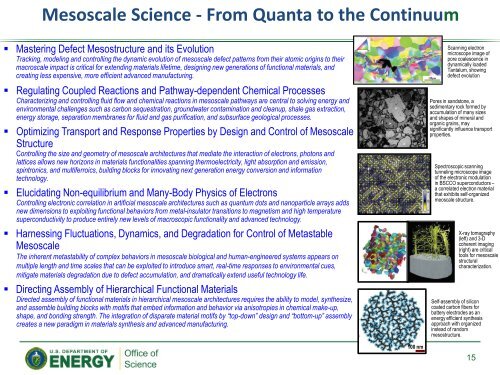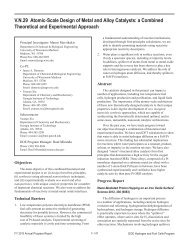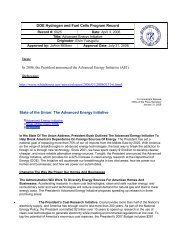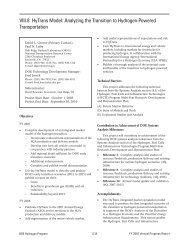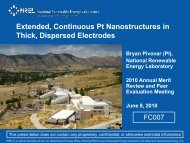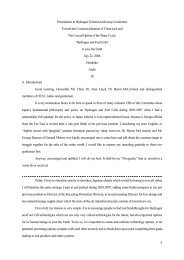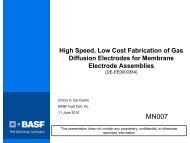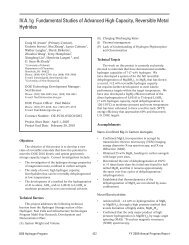DOE Basic Energy Sciences Program Overview - U.S. Department of ...
DOE Basic Energy Sciences Program Overview - U.S. Department of ...
DOE Basic Energy Sciences Program Overview - U.S. Department of ...
You also want an ePaper? Increase the reach of your titles
YUMPU automatically turns print PDFs into web optimized ePapers that Google loves.
Mesoscale Science - From Quanta to the Continuum<br />
• Mastering Defect Mesostructure and its Evolution<br />
Tracking, modeling and controlling the dynamic evolution <strong>of</strong> mesoscale defect patterns from their atomic origins to their<br />
macroscale impact is critical for extending materials lifetime, designing new generations <strong>of</strong> functional materials, and<br />
creating less expensive, more efficient advanced manufacturing.<br />
• Regulating Coupled Reactions and Pathway-dependent Chemical Processes<br />
Characterizing and controlling fluid flow and chemical reactions in mesoscale pathways are central to solving energy and<br />
environmental challenges such as carbon sequestration, groundwater contamination and cleanup, shale gas extraction,<br />
energy storage, separation membranes for fluid and gas purification, and subsurface geological processes.<br />
• Optimizing Transport and Response Properties by Design and Control <strong>of</strong> Mesoscale<br />
Structure<br />
Controlling the size and geometry <strong>of</strong> mesoscale architectures that mediate the interaction <strong>of</strong> electrons, photons and<br />
lattices allows new horizons in materials functionalities spanning thermoelectricity, light absorption and emission,<br />
spintronics, and multiferroics, building blocks for innovating next generation energy conversion and information<br />
technology.<br />
• Elucidating Non-equilibrium and Many-Body Physics <strong>of</strong> Electrons<br />
Controlling electronic correlation in artificial mesoscale architectures such as quantum dots and nanoparticle arrays adds<br />
new dimensions to exploiting functional behaviors from metal-insulator transitions to magnetism and high temperature<br />
superconductivity to produce entirely new levels <strong>of</strong> macroscopic functionality and advanced technology.<br />
• Harnessing Fluctuations, Dynamics, and Degradation for Control <strong>of</strong> Metastable<br />
Mesoscale<br />
The inherent metastability <strong>of</strong> complex behaviors in mesoscale biological and human-engineered systems appears on<br />
multiple length and time scales that can be exploited to introduce smart, real-time responses to environmental cues,<br />
mitigate materials degradation due to defect accumulation, and dramatically extend useful technology life.<br />
• Directing Assembly <strong>of</strong> Hierarchical Functional Materials<br />
Directed assembly <strong>of</strong> functional materials in hierarchical mesoscale architectures requires the ability to model, synthesize,<br />
and assemble building blocks with motifs that embed information and behavior via anisotropies in chemical make-up,<br />
shape, and bonding strength. The integration <strong>of</strong> disparate material motifs by “top-down” design and “bottom-up” assembly<br />
creates a new paradigm in materials synthesis and advanced manufacturing.<br />
Scanning electron<br />
microscope image <strong>of</strong><br />
pore coalescence in<br />
dynamically loaded<br />
Tantalum, showing<br />
defect evolution<br />
Pores in sandstone, a<br />
sedimentary rock formed by<br />
accumulation <strong>of</strong> many sizes<br />
and shapes <strong>of</strong> mineral and<br />
organic grains, may<br />
significantly influence transport<br />
properties.<br />
Spectroscopic scanning<br />
tunneling microscope image<br />
<strong>of</strong> the electronic modulation<br />
in BSCCO superconductors –<br />
a correlated electron material<br />
that exhibits self-organized<br />
meoscale structure.<br />
X-ray tomagraphy<br />
(left) and 3-D<br />
coherent imaging<br />
(right) are critical<br />
tools for mesoscale<br />
structural<br />
characterization.<br />
Self-assembly <strong>of</strong> silicon<br />
coated carbon fibers for<br />
battery electrodes as an<br />
energy efficient synthesis<br />
approach with organized<br />
instead <strong>of</strong> random<br />
mesostructure.<br />
100 nm<br />
15


